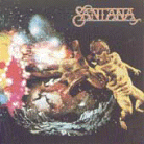![]()
  |

Santana III
Santana
Columbia 30595
Released: October 1971
Chart Peak: #1
Weeks Charted: 39
Certified Double Platinum: 11/21/86
 Santana goes back deep into the roots of today's music, not only just to the time when the Family Dog was at the Avalon, but back further into the heavy dosages of Latin and African rhythms that have been part of American music for a long time.
Santana goes back deep into the roots of today's music, not only just to the time when the Family Dog was at the Avalon, but back further into the heavy dosages of Latin and African rhythms that have been part of American music for a long time.
For it's surely true that for all their Fender basses and fuzz tones, Santana is more deeply committed to the music defined and still played by Tito Puente, Machito, Mongo Santamaria, and all the glorious combinations of brass and rhythm that made the old Sunday afternoon dances such a delight, than to the Rolling Stones. Santana's music is contemporary, but it comes from a tradition and part of what has provoked a curious reluctance on the part of some hard rock fans to accept Santana is that tradition. This is music to dance to, but it is music that shrieks for more advanced, dextrous and imaginative dancing than some of the free form body motion that rock dancing has accepted. It is also music that asks for a certain kind of emotional abandon for maximum enjoyment. You don't just listen to Santana; you get inside the rhythm, play it in your head or your body and participate.
The first time I heard this band properly was at one of the Family Dog dances at the Avalon and they were tremendously exciting. That's a hallmark of Santana, it's continual high level of excitement. When the band drops down from that high tension wire for a number or for a movement, it usually enters into one of those romantic lyric passages that Anglos have come to associate with syrupy sentimentality. But one man's sentimentality is another's pure emotion and Santana really is an emotional band.
Lyrics are almost secondary to instrumental virtuosity with Santana and so are vocals. Frequently the lyrics are utilized as single lines for a unison shout or chant that in itself evolves into a rhythmic pattern played against the sounds the band is producing. Thus the band actually becomes an extended essay in rhythm.
Their new album goes right along with their previous ones in its content except that, for me anyway, it is more consistent. Prior Santana albums have had amazing things for me but also some downers. This LP stays there all the way. The work of the Tower of Power horn section and of Luis Gasca (ex-Woody Herman trumpeter and leader of his own group on a fine LP last year) helps, of course, by giving that punching brass sound that fits so well with this kind of music. The songs are all by the group except for Gene Ammons' now classic "Jungle Strut" and Tito Puente's "Para Los Rumberos" (which has Carlos Santana's name substituted in the last chorus of the vocal for a nice bit).
Sometime I would like to see an analysis of the rhythms and patterns used by Santana done by some ethno-musicologist who could relate them to traditional Cuban, African and Haitian music and styles. I suspect it would be quite revealing. I am convinced that this band, which is really a city band bringing us the hot pavement and the cool nights as well as the rumble and the roar of the city, is solidly linked back to the hill country, the savannahs and the inland plains music of Africa and Cuba and the other sources of that magic rhythmic power of which they are such compelling examples.
- Ralph J. Gleason, Rolling Stone, 11/25/71.
Bonus Reviews!
In theory, the polyrhythms intensified the momentum while the low-defintion songwriting served the freeflow gestalt. In fact, the Latin lilt lighted the beat and the flow remained muddy indeed. So the electricity generated by the percussion-heavy opening cut comes as a pleasant surprise, and the movement of what follows is a surprising pleasure. New second guitarist Neal Schon deserves a special thanks for crowding out Gregg Rolie's organ. Maybe soon he'll come up with more than one idea per solo. B
- Robert Christgau, Christgau's Record Guide, 1981.
Completes a trilogy of tightly constructed, exciting band albums filled with percolating, multirhythmic percussion and fiery guitar work. The last album that is the work of the Woodstock-era Santana band. * * * *
- William Ruhlmann, The All-Music Guide to Rock, 1995.
For Santana's third album, the band brought in additional percussion, Neal Schon on guitar, the Tower of Power horns and romped through a walloping Santana III that proved to be the swan song of the original band. * * * *
- Joel Selvin, Musichound Rock: The Essential Album Guide, 1996.
(2006 Legacy Edition) There's already plenty of arresting music on Santana's third studio album, and this expanded version adds unreleased studio jams "Gumbo" and "Folsom Street - One." But the real lure is Disc Two, which offers Santana's entire late-night performance on July 4th, 1971, at the Fillmore West, bits of which have appeared on other releases. The band performed a chunk of III in sequence, adding thrilling trips through "In a Silent Way" and "Incident at Neshabur." Everybody sounds stoked -- the rhythm section drives guitarist Carlos Santana into simultaneously agitated and poised solos (see "No One to Depend On") that sustain an elusive state of polyrhythmic bliss. * * * *
- Tom Moon, Rolling Stone, 3/23/06.
![]() Reader's Comments
Reader's Comments
No comments so far, be the first to comment.